The 2023 January transfer window has slammed shut. In Ligue 1, we’ve seen plenty of noteworthy moves take place over the course of the month, some of the most interesting of which came in the dying days of this period.
This scout report will look at five of the late-January moves we consider standouts in terms of intrigue and believe to be worth monitoring.
We’ve used a mixture of data and video analysis for this piece. Our tactical analysis discusses how the selected players may contribute to their new teams’ tactics, considering major strengths, weaknesses, specific player traits and characteristics, as well as potential roles they could occupy within their new teams.
Terem Moffi to Nice
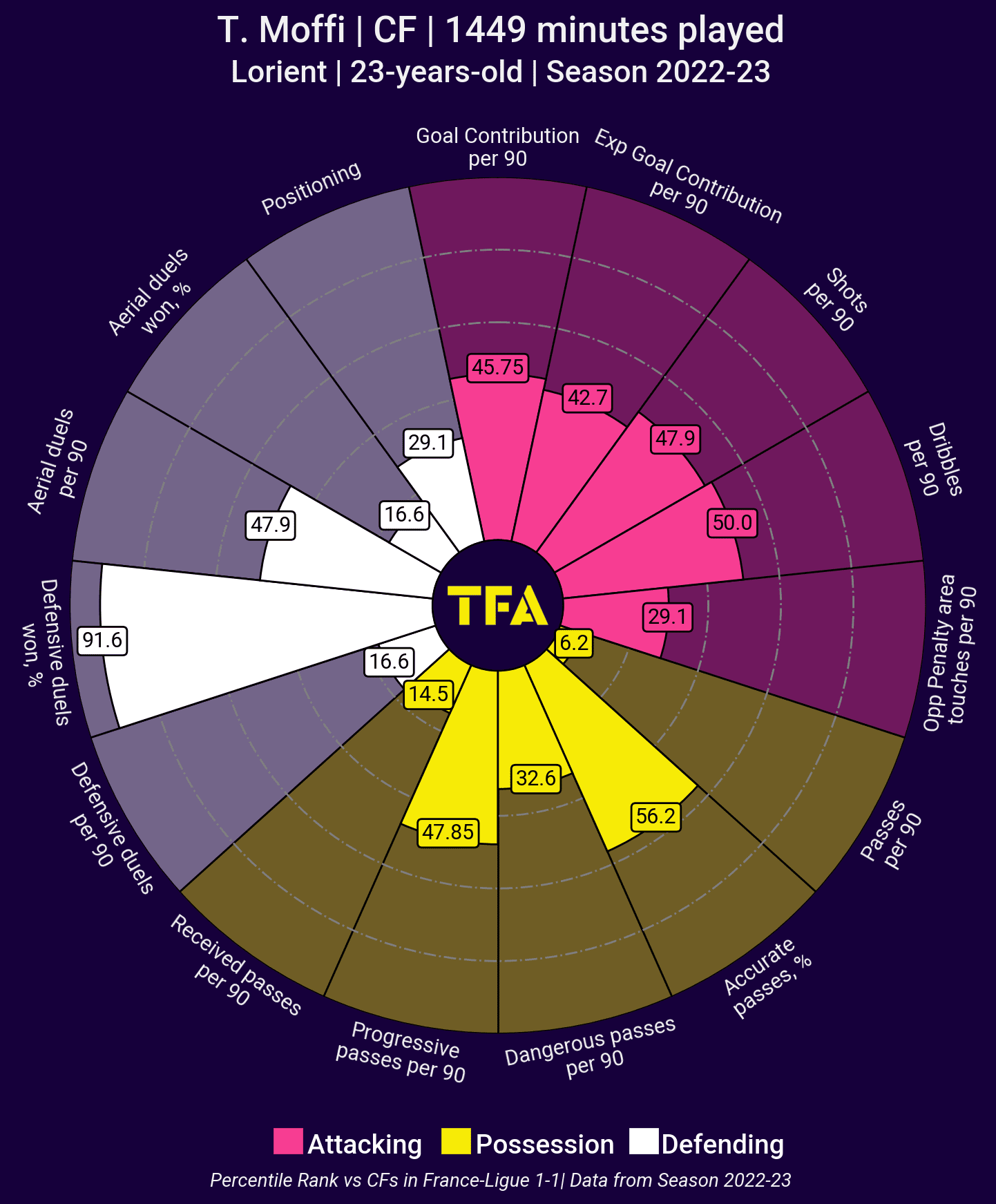
We’ll kick off our analysis by looking at Terem Moffi, who moved from Ligue 1’s seventh-placed side Lorient to eighth-placed Nice. Figure 1 above is a pizza chart displaying Moffi’s percentile rankings among Ligue 1 centre-forwards from the 2022/23 campaign.
In terms of passing, Moffi wasn’t heavily involved at Lorient and definitely wouldn’t be described as a ‘playmaker’ as such. However, the Nigerian attacker has a decent level of hold-up ability and, crucially, used his movement when dropping to offer himself as a passing option with his back to goal to drag defenders in and create space for others around him.
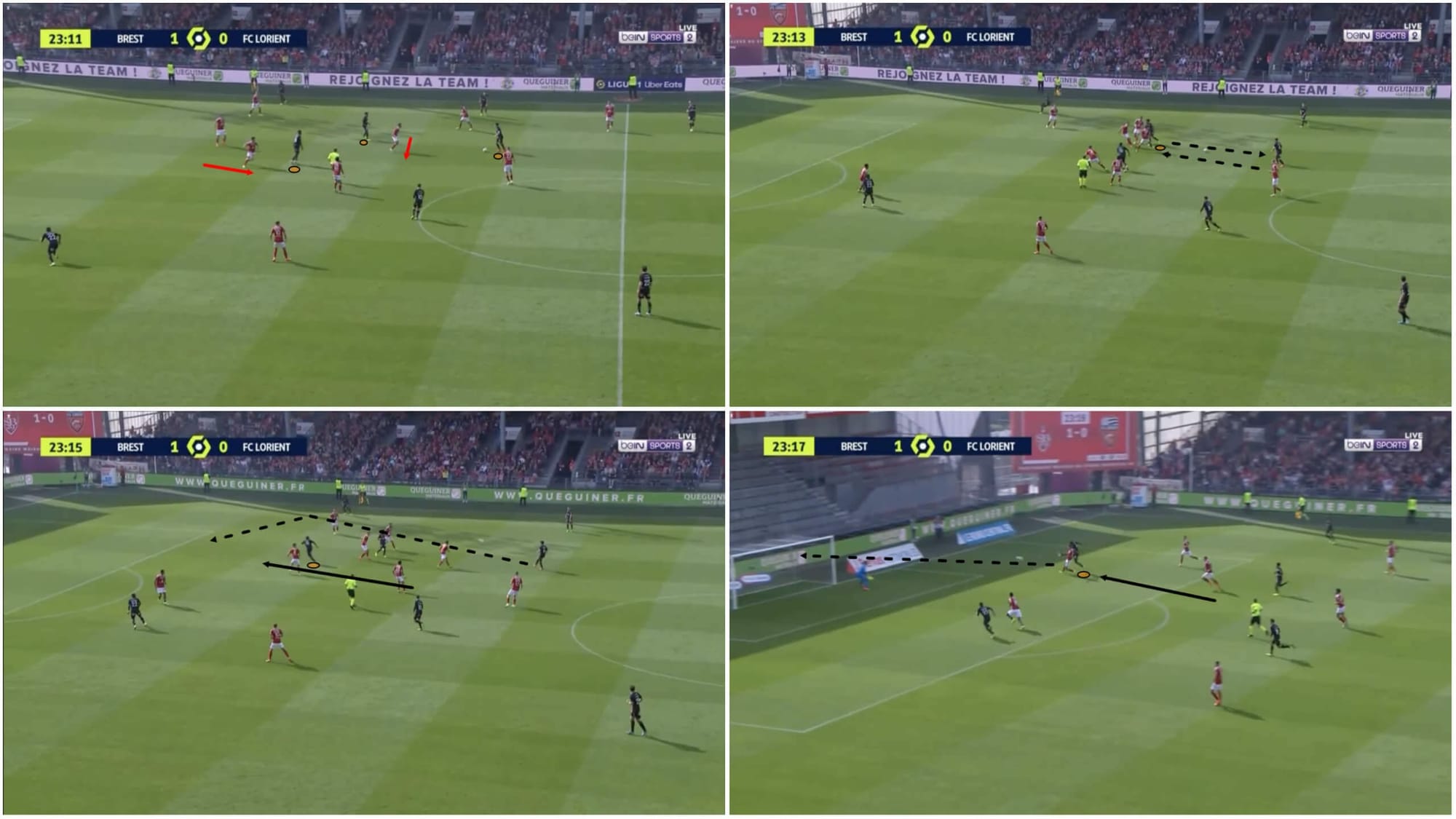
Moffi can be a real handful for defenders, especially after he turns and begins steaming towards them. As a result, defenders often try to stick close to him and prevent him from turning. This can then create space for his teammates. This was the case in the top-left of figure 2, as one defender closes Moffi down from behind and another blocks the passing lane from the ball carrier to him.
With his magnetism, Moffi creates space for the ball carrier to link up with another teammate. From there, the ball gets played back to the initial ball carrier and the pressure is relieved on Moffi. This gives the centre-forward space to get away in behind.
At Nice, Moffi’s magnetism will be relished by the likes of the former London residents, on-loan Arsenal man Nicolas Pépé and ex-Chelsea player Ross Barkley, as they’ll enjoy utilising the extra space their new frontman generates for them.
Additionally, they’ll enjoy the attacking options he provides them with his exceptional movement and offensive positioning, as well as his excellent knowledge of and use of his body as protection for the ball and a battering ram for defenders in high-value goalscoring positions. This makes the left-footed striker difficult to deal with as he charges into goalscoring positions, giving his team’s creators a good passing option or charging into a shooting position himself after receiving the ball earlier, protecting the prized possession with his large, 188cm/6’2” frame.
Moffi isn’t a target man, he is at his best and most dangerous offensively when played towards goal with space to charge into. Expect to see him utilised in this manner at Nice, with balls typically being played to him when facing the opposition’s goal, not with his back to goal. Moffi likes to play on opposition defenders’ shoulders, aiming to exploit space as it opens up behind the backline. Once he builds up some pace, he can be a difficult man to stop when charging towards goal.
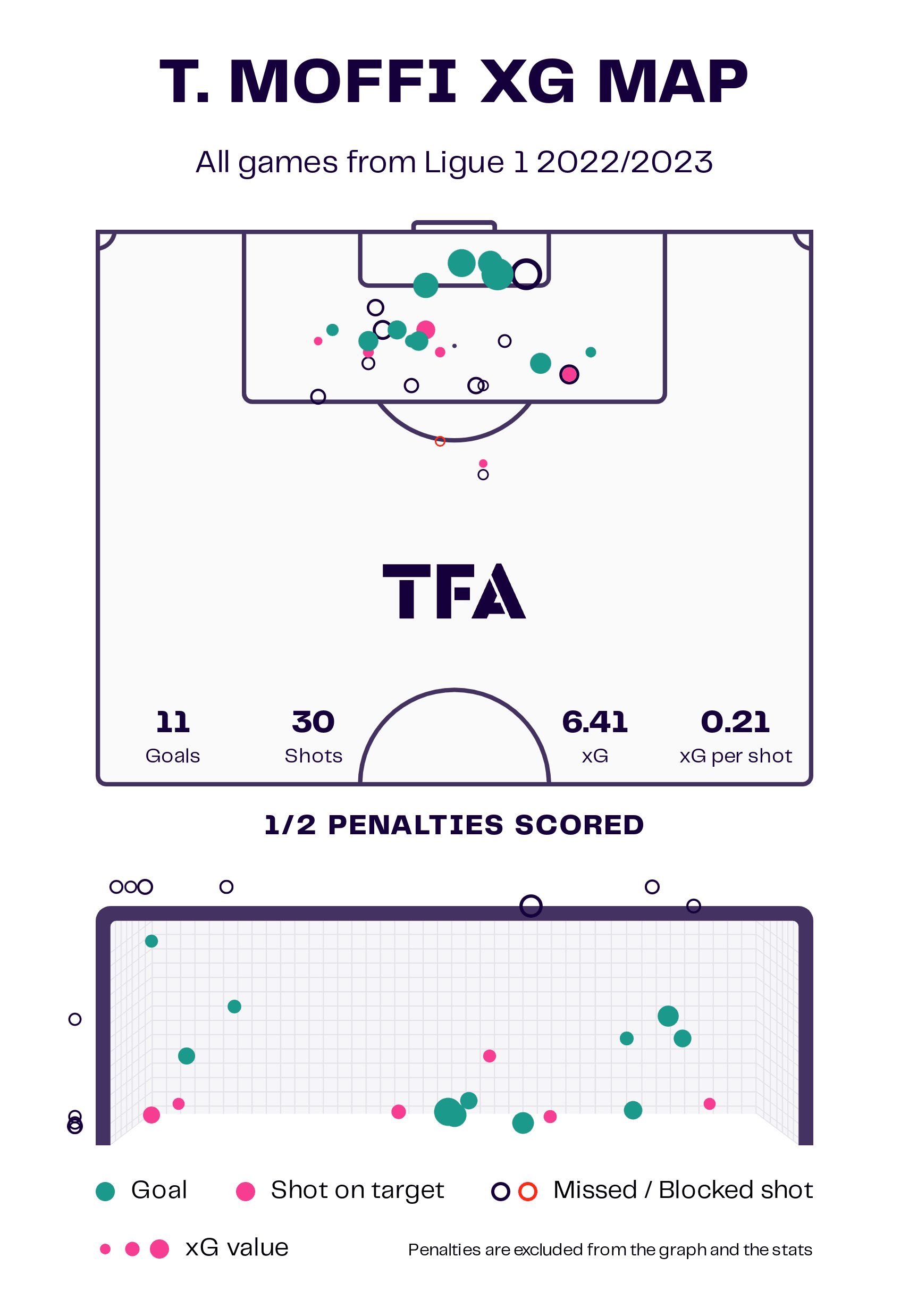
Through really intelligent movement inside the box when looking to finish off moves and outside the box during the chance creation phase, along with his excellent use of his body as an offensive weapon, Moffi has generated 6.41 xG in Ligue 1 this season — a very nice 0.21 xG per shot. His shot selection is typically good thanks to his great movement inside the box and ability to create separation from defenders in order to get a shot off. He has retained a good 59.38% shot accuracy rate this term.
Aerially, Moffi isn’t incredibly strong but he can offer a threat from set-pieces via his movement and can score aerially. Again, though, we must reiterate, he’s not a player you sign in order to have a big target man up top winning aerial duels left, right and centre or holding up the play for your team.
In Moffi, Nice have added a great offensive weapon to their team. Now, they need to play to his strengths inside the final third and ensure they get the best out of the 23-year-old who is likely to end up being the club’s record transfer signing when all fees have been paid for this deal, which is initially a loan but with an obligatory purchase clause.
Bamba Dieng to Lorient
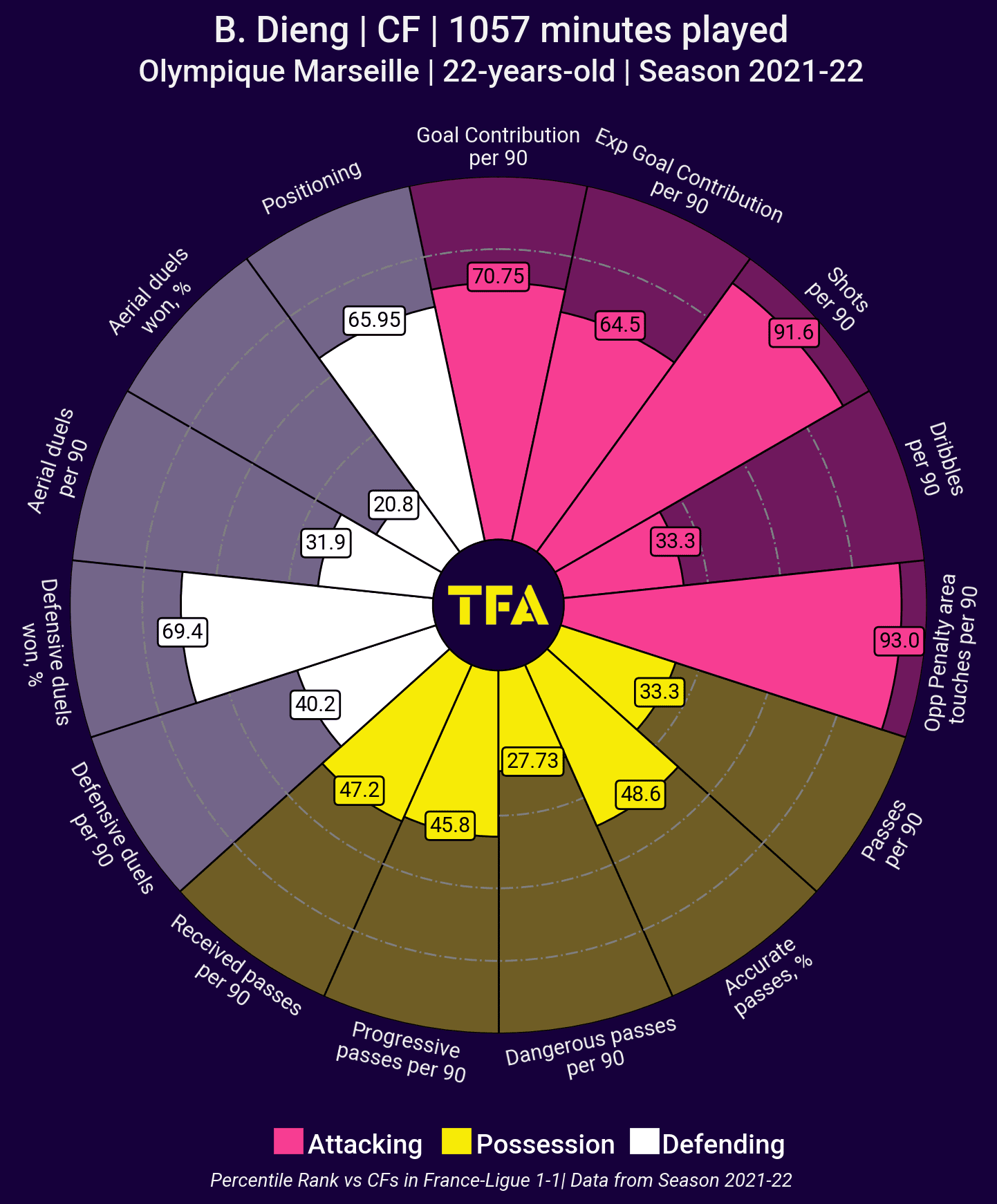
Next up, we’ll look at the 22-year-old who has been signed by Lorient for €7m as Moffi’s replacement, Bamba Dieng, formerly of Marseille. In figure 4, we see his pizza chart with numbers from the 2021/22 season rather than 2022/23 — the only player in our scout report who this is the case for. We used last season’s data instead of this season as Dieng has hardly featured in Ligue 1 this term so far, and this season’s numbers wouldn’t tell us an awful lot.
As is evident from his pizza chart in figure 4, Dieng is a high-volume shooter with a solid expected goal contribution and actual goal contribution rate relative to other Ligue 1 centre-forwards from last season.
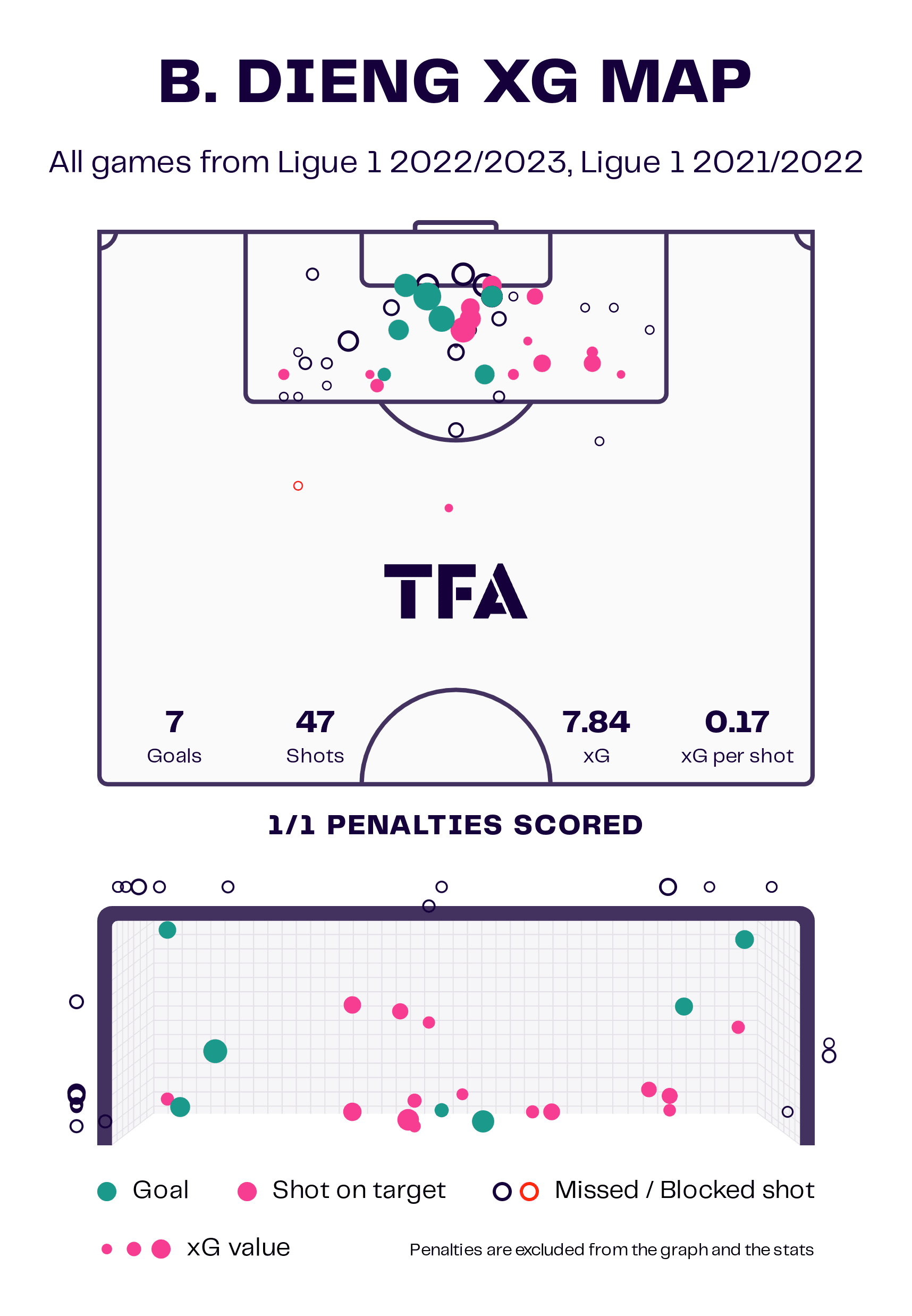
Dieng has an excellent xG per 90 of 0.62 for the last calendar year in Ligue 1, on top of a decent 3.3 shots per 90. This, along with his xG per shot of 0.17 for the last two seasons per figure 5, all indicates his ability to generate a lot of high-quality chances when he plays, hence why Lorient have decided to go for him as Moffi’s replacement. He’s frequently popping up in good positions to take a crack at goal, a solid indicator of his positional sense and offensive movement.
The 5’10” striker is more limited in terms of his all-around game than Moffi or many other centre-forwards. He doesn’t offer the same benefits as previously discussed when looking at Moffi during the chance creation phase via his movement and his dribbling quality is worse than Moffi’s.
However, he generates lots of touches inside the box and chances from high-value areas, which is a quality Lorient will look to capitalise on.
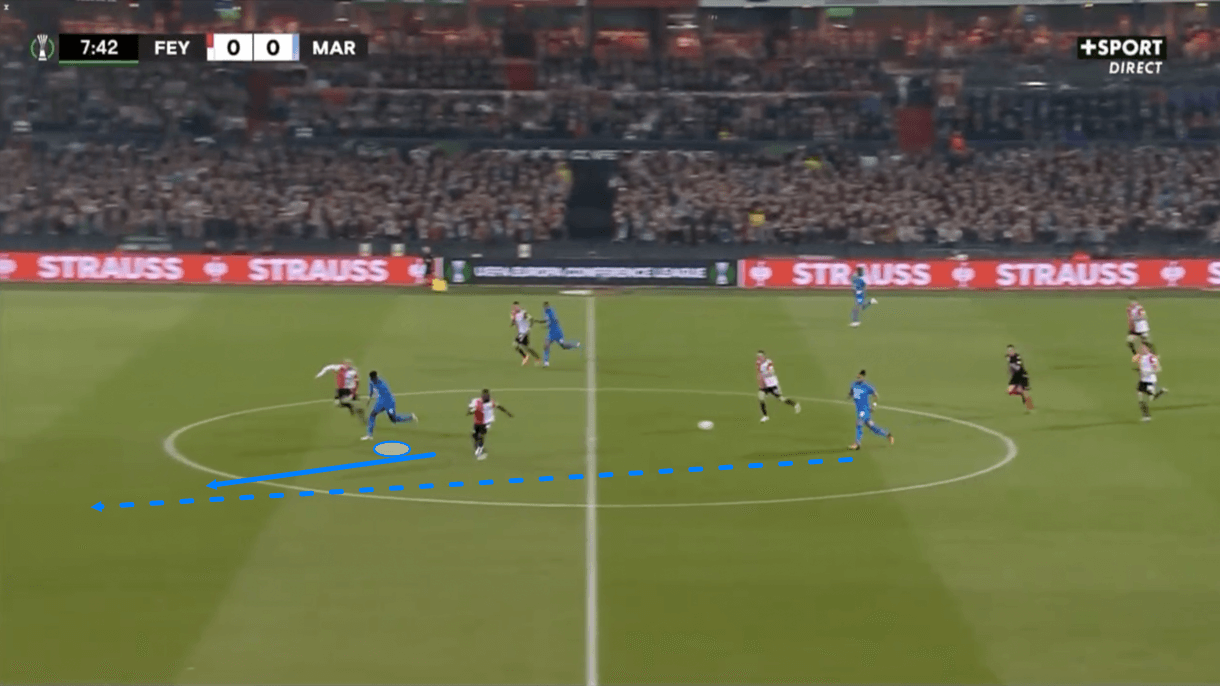
Dieng is a pacey forward who loves to play on defenders’ shoulders and chase down balls played in behind whether it’s a through pass like the one we see in figure 6 or a long ball over the top. His new teammates must always be on the lookout for Dieng’s movement intending to give them an option in behind the backline. If they can spot his run and find him with a ball in behind or over the top, his pace makes him very difficult for the opposition to catch.
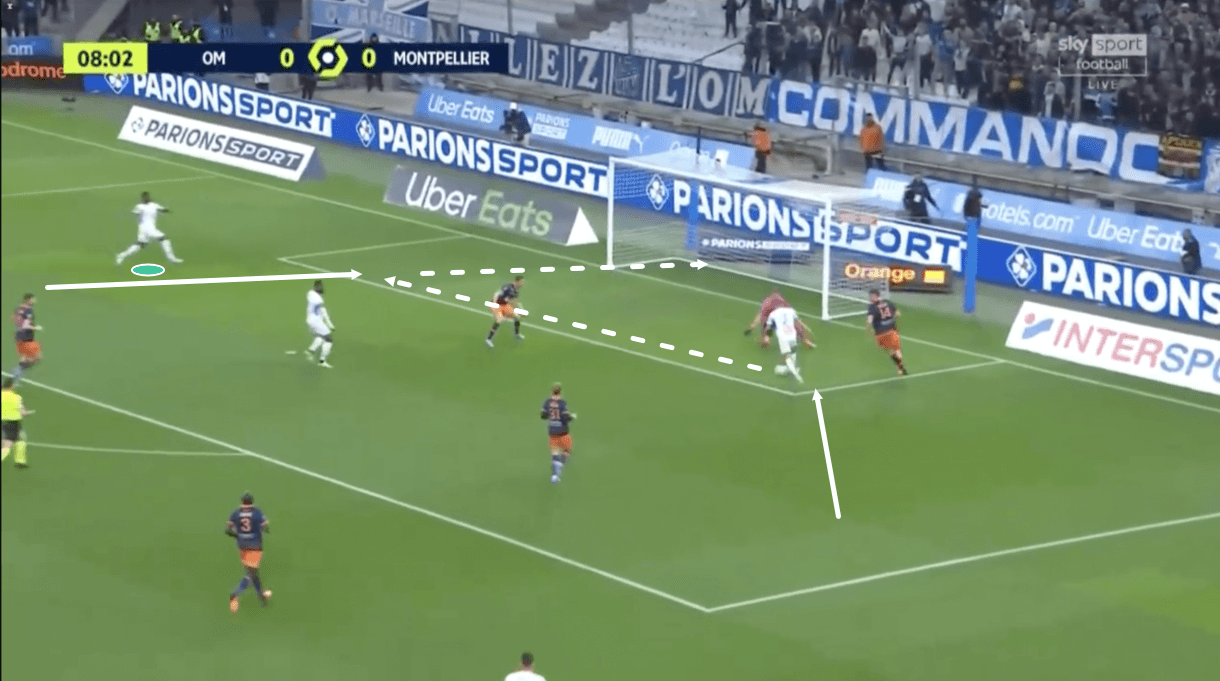
It’s also common to see Dieng providing an option at the back post when arriving in the box via a late run, such as the one shown in figure 7.
In terms of his finishes, Dieng is great at striking the ball powerfully while keeping it low. He likes shooting across goal and is also capable of pulling off acrobatic finishes. The 22-year-old is able to shift his body in such ways that he ensures he gets something on the ball and directs it towards goal even in difficult situations.
He’ll provide excellent movement in dangerous areas similar to Moffi but will provide less in terms of his all-around game and is clearly a different forward. His signing is one that could pay off big time for Lorient if their impressive coach Régis Le Bris can tweak his system to exploit their new striker’s biggest strengths, as discussed above.
Azzedine Ounahi to Marseille
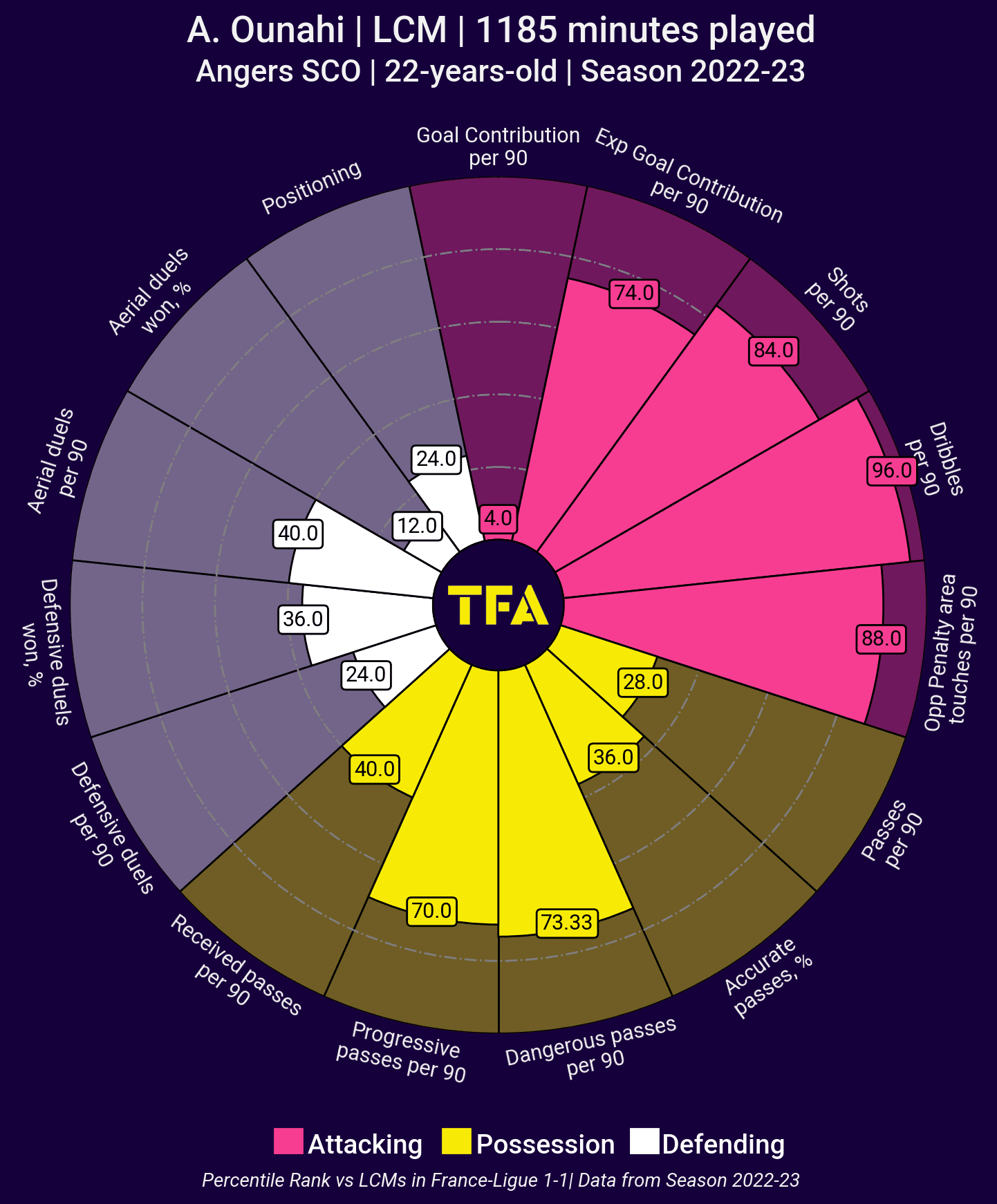
Following an impressive FIFA World Cup in which he truly announced himself on the global stage, 22-year-old central midfielder Azzedine Ounahi got his transfer move from bottom-of-the-table Angers to title-contending Marseille late in the January transfer window. With Ounahi’s €8m sale, Angers made a hefty profit on the Moroccan they signed for €70k back in the summer of 2021.
I believe it was a good time for Angers to cash in on Ounahi given how much his stock rose following the World Cup, though they will probably have initially wanted more than the €8m they eventually got for him late on in January given the levels of hype that circulated about the midfielder following the World Cup. Nevertheless, a move to Marseille can be a good move for the 22-year-old and could provide him a chance to prove that he can sustain his performance levels of the World Cup over a longer period, though that remains to be seen.
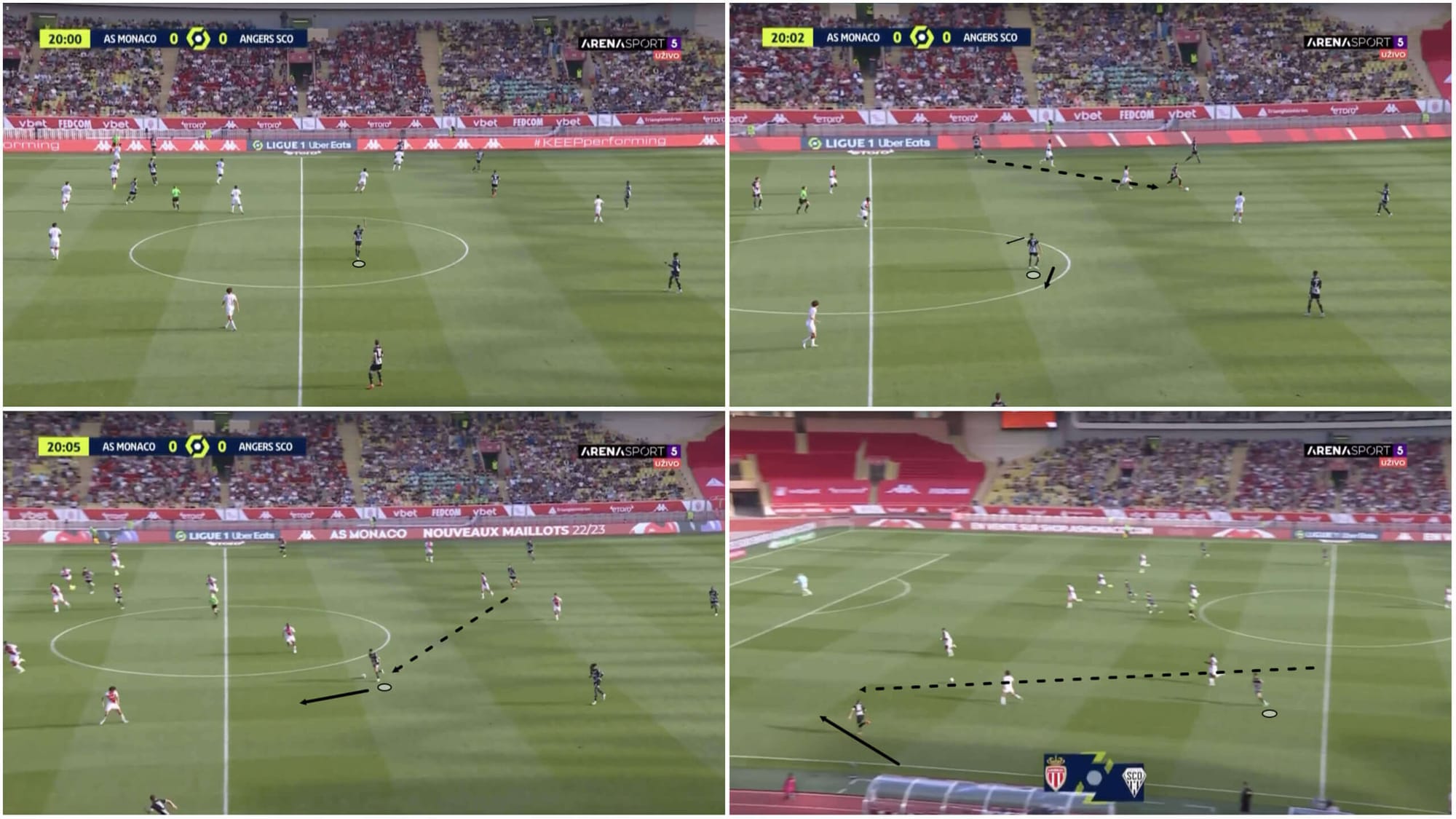
Ounahi is a creative midfielder who plays with refreshing freedom on the ball. He’s a delight to watch drift off into space, receive, turn and either drive forward to take on the opposition defenders or slide the ball into a teammate’s running path ahead of him. We see an example of a typical Ounahi involvement via a progressive pass in figure 9 above.
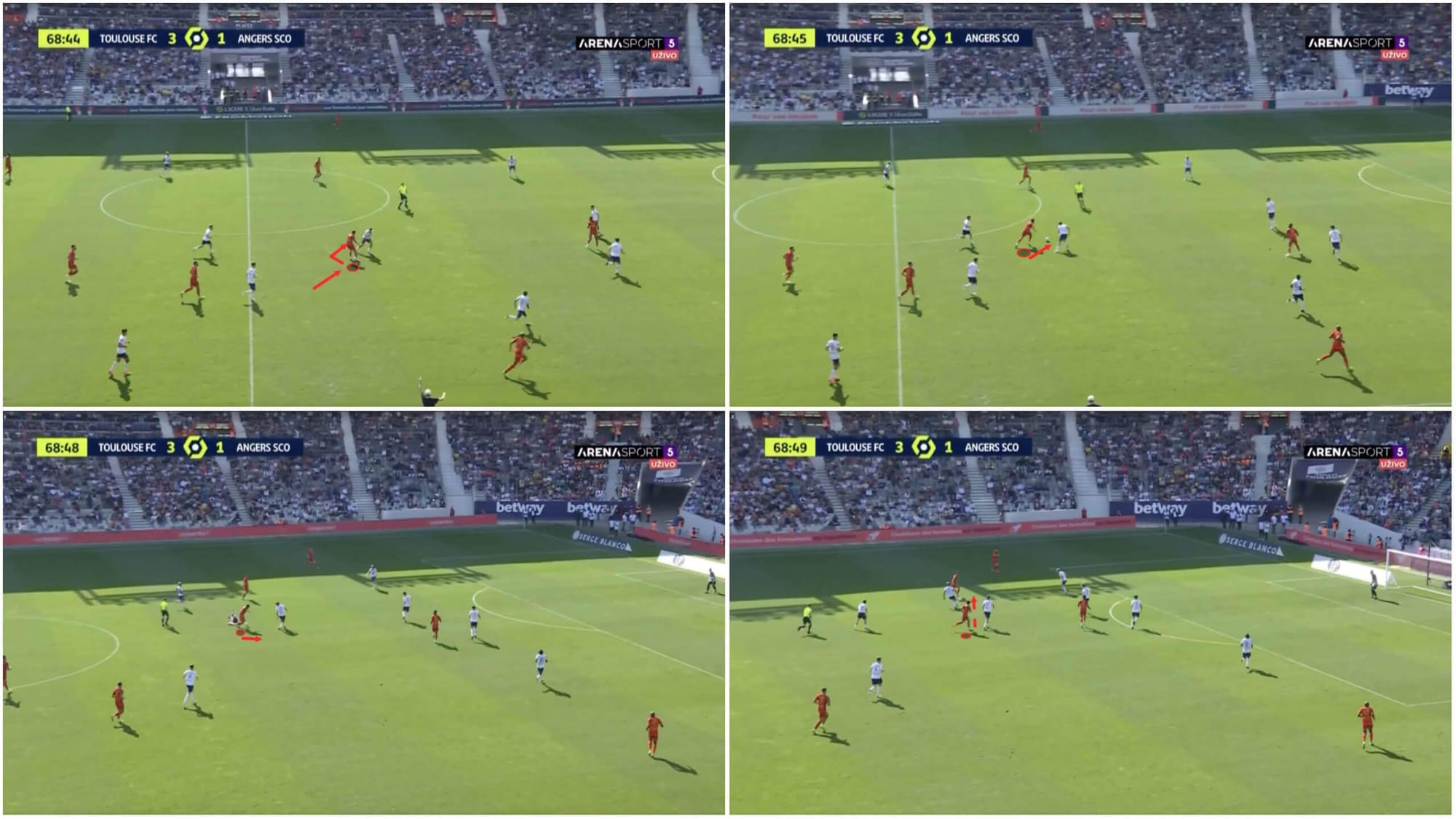
Meanwhile, we can see an example of the midfielder’s ball-carrying quality in figure 10. Here, he essentially dances past the defender thanks to his quick feet, agility and hip flexibility.
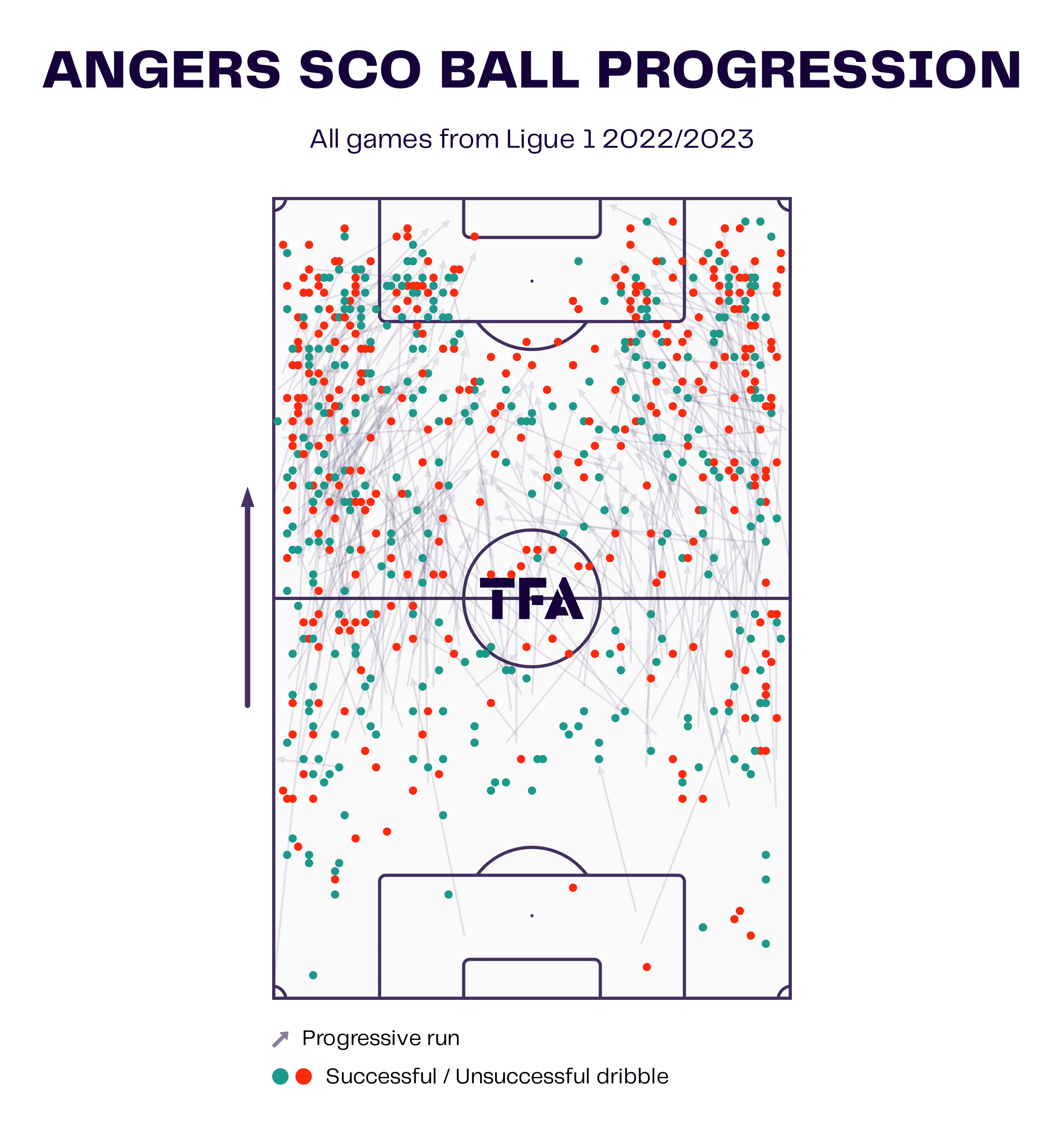
Figure 11 shows Angers’ ball progression map from this season. We see plenty of their progressive runs and dribbles coming from central areas, many of which were performed by Ounahi from his left central midfield position.
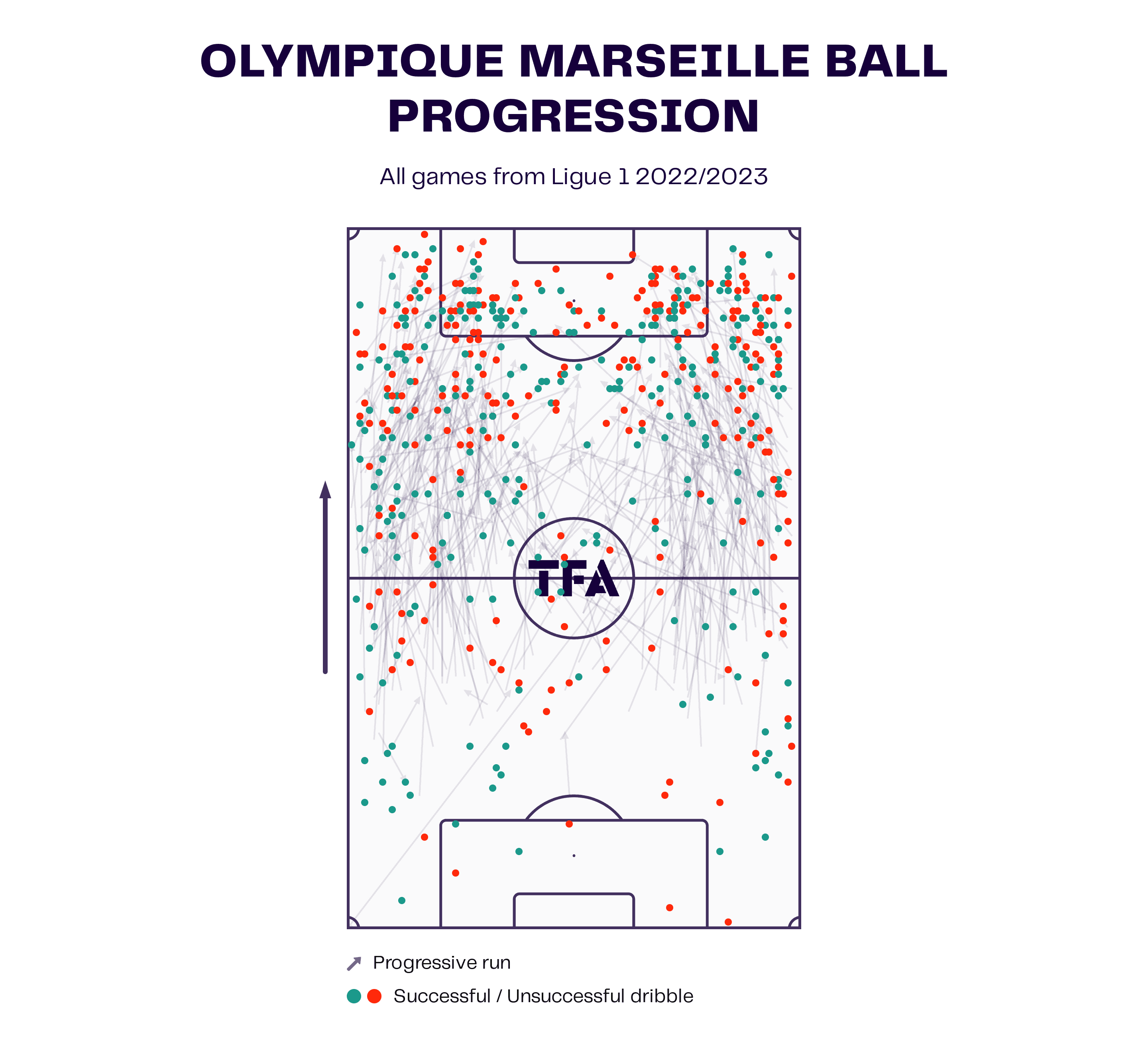
Marseille have made fewer progressive runs and dribbles from central areas this term, with most of their carries coming from wide areas, particularly via the likes of right wing-back Jonathan Clauss, left wing-back Nuno Tavares and wide attacker Cengiz Ünder.
It’s possible Marseille boss Igor Tudor envisages a change of system for Les Phocéens in the near future, but they’ve been quite rigid in terms of their system and shape this season so it wouldn’t surprise us to see Ounahi fit into their existing 3-4-2-1, where he’d probably be best-suited to the left attacking midfielder role behind the striker.
From here, he’d be required to find space, receive on the half-turn and drive at the backline often, carrying creative responsibilities within the final third. He may end up making fewer progressive passes than he did at Angers in this role at Marseille but more dangerous passes and perhaps generating more direct goal contributions if he performs the role well.
Banking on Ounahi was a risk in January but at €8m, the risk isn’t a massive one and the upside is huge. Time will tell if it pays off for Marseille and we may well end up looking back on this deal as being just as huge a bargain as the one Angers got when they signed Ounahi for €70k a couple of years back. For us, this is a good next step for the 22-year-old’s development and a chance to evolve himself at a slightly higher level with a Marseille side hoping to compete in the UEFA Champions League next term.
Ibrahima Niane to Angers
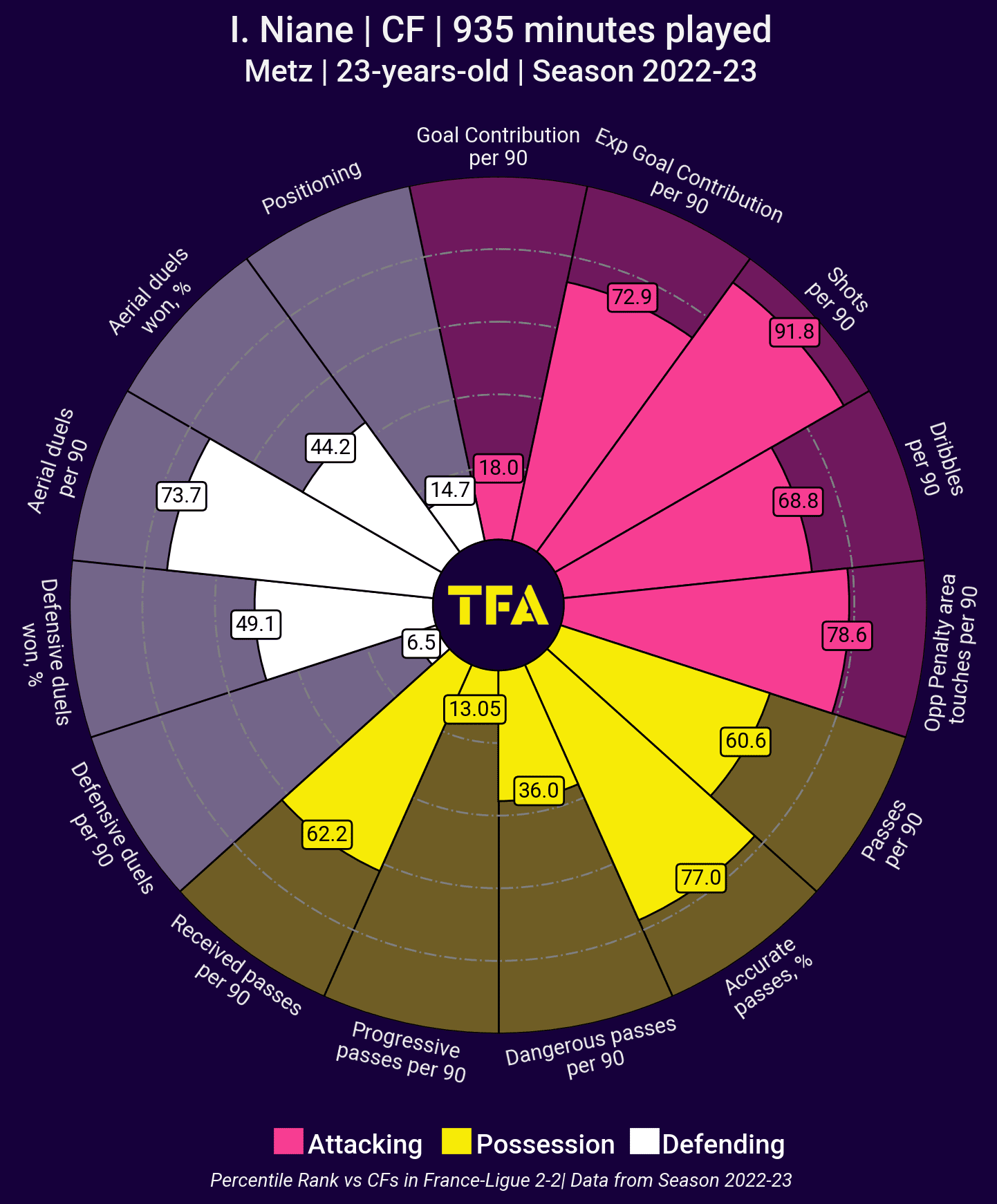
The third and final centre-forward on our list is 23-year-old Ibrahima Niane, who joined Ligue 1’s bottom-placed side, Azzedine Ounahi’s former team Angers, from Ligue 2 Metz on loan with an option for the club to make the deal permanent at the end of the season. Figure 13, the player’s pizza chart from 2022/23 comparing him with other centre-forwards in Ligue 2, displays some key information about Niane; he’s a high-volume shooter (2.79 per 90) and he’s got a high expected goal contribution, but a low actual goal contribution for 2022/23.
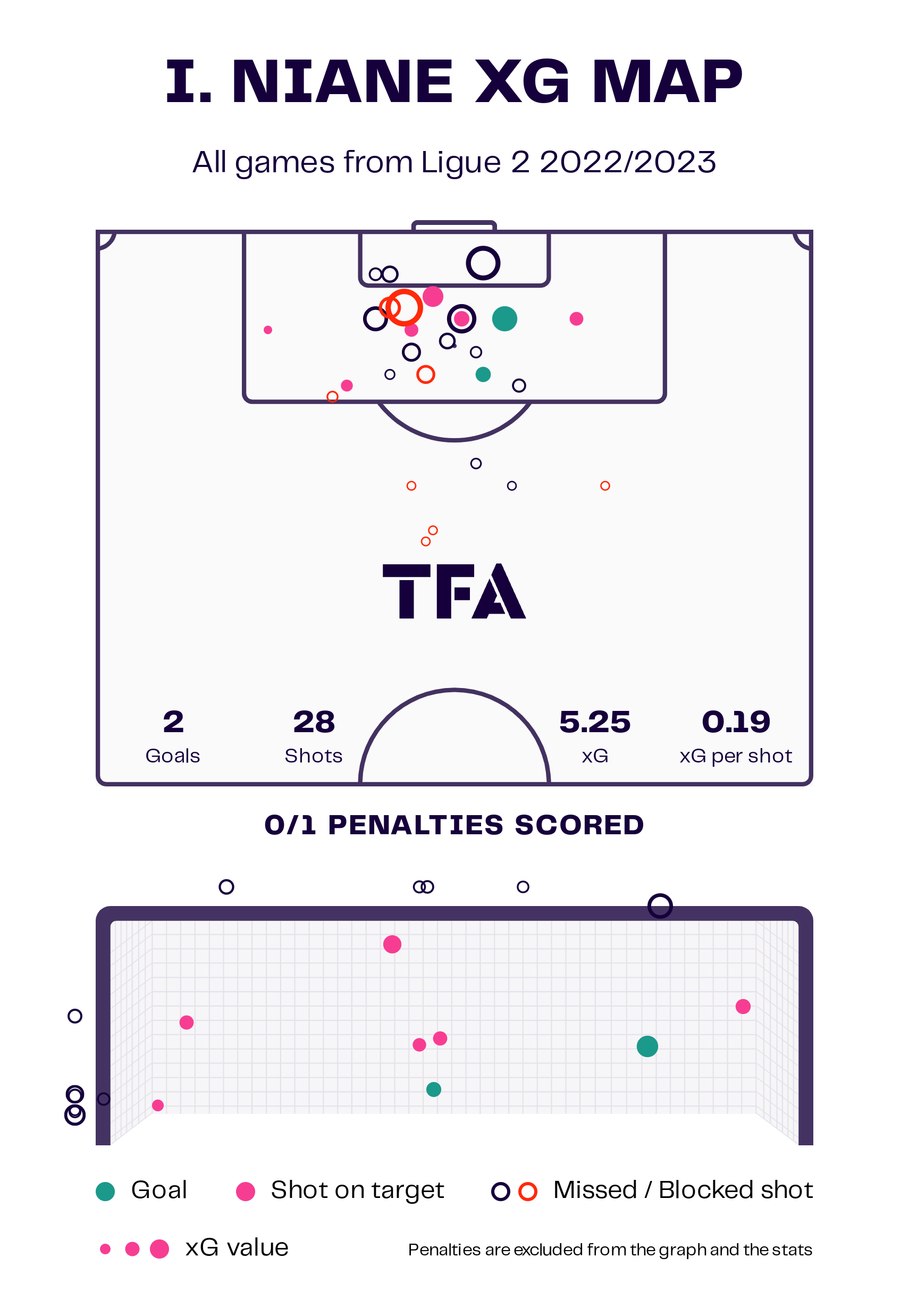
Indeed, Niane’s generated 5.25 xG this season while he’s scored just two goals. His xG per shot is impressive at 0.19, but he’s struggled to turn those opportunities into real goals, unfortunately for Metz, who currently sit fifth in the second tier and could’ve done with a few extra goals to potentially send them beyond some of their nearest rivals and up the table.
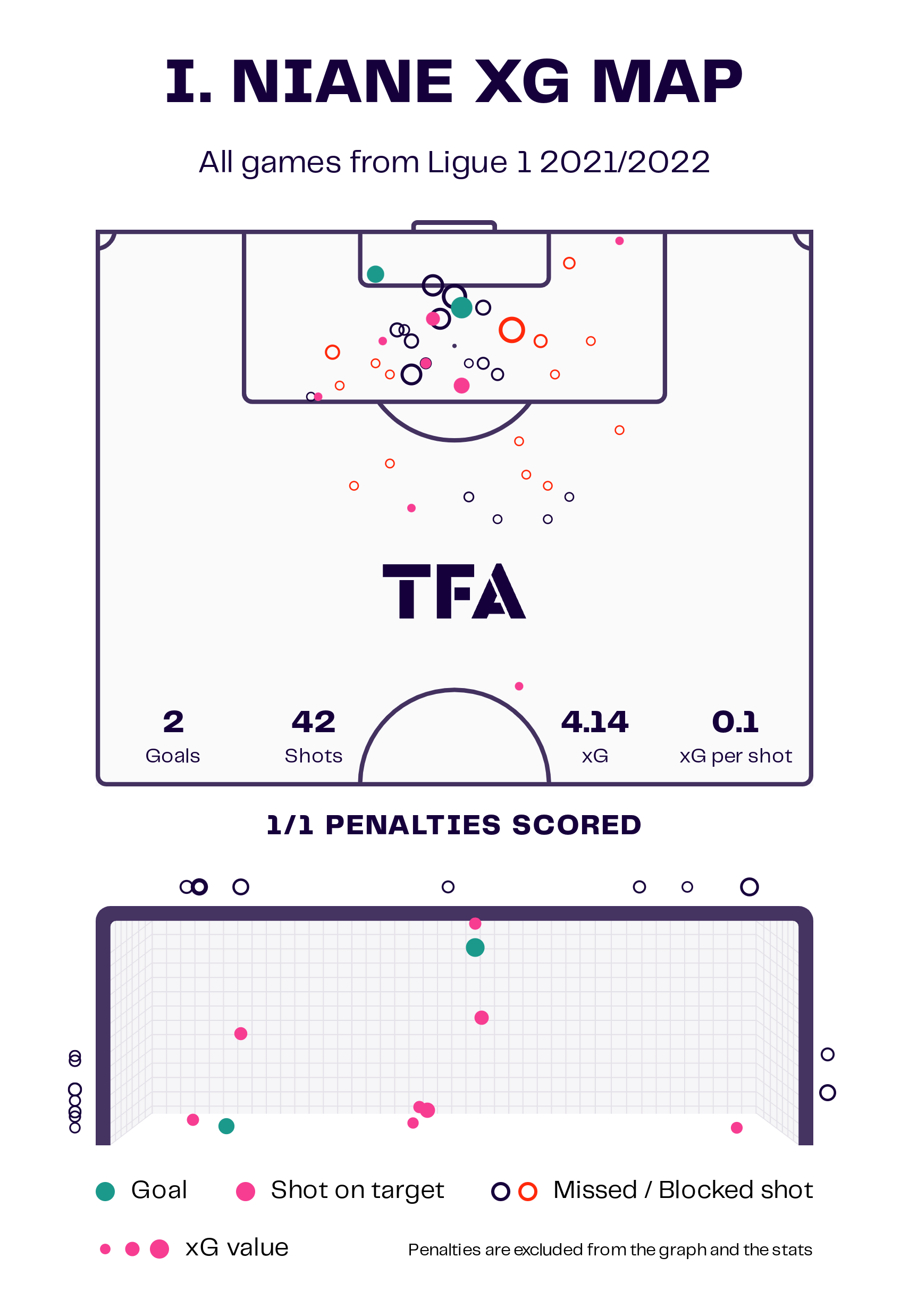
Last season, with Metz in Ligue 1, Niane also underperformed his xG by more than two goals.
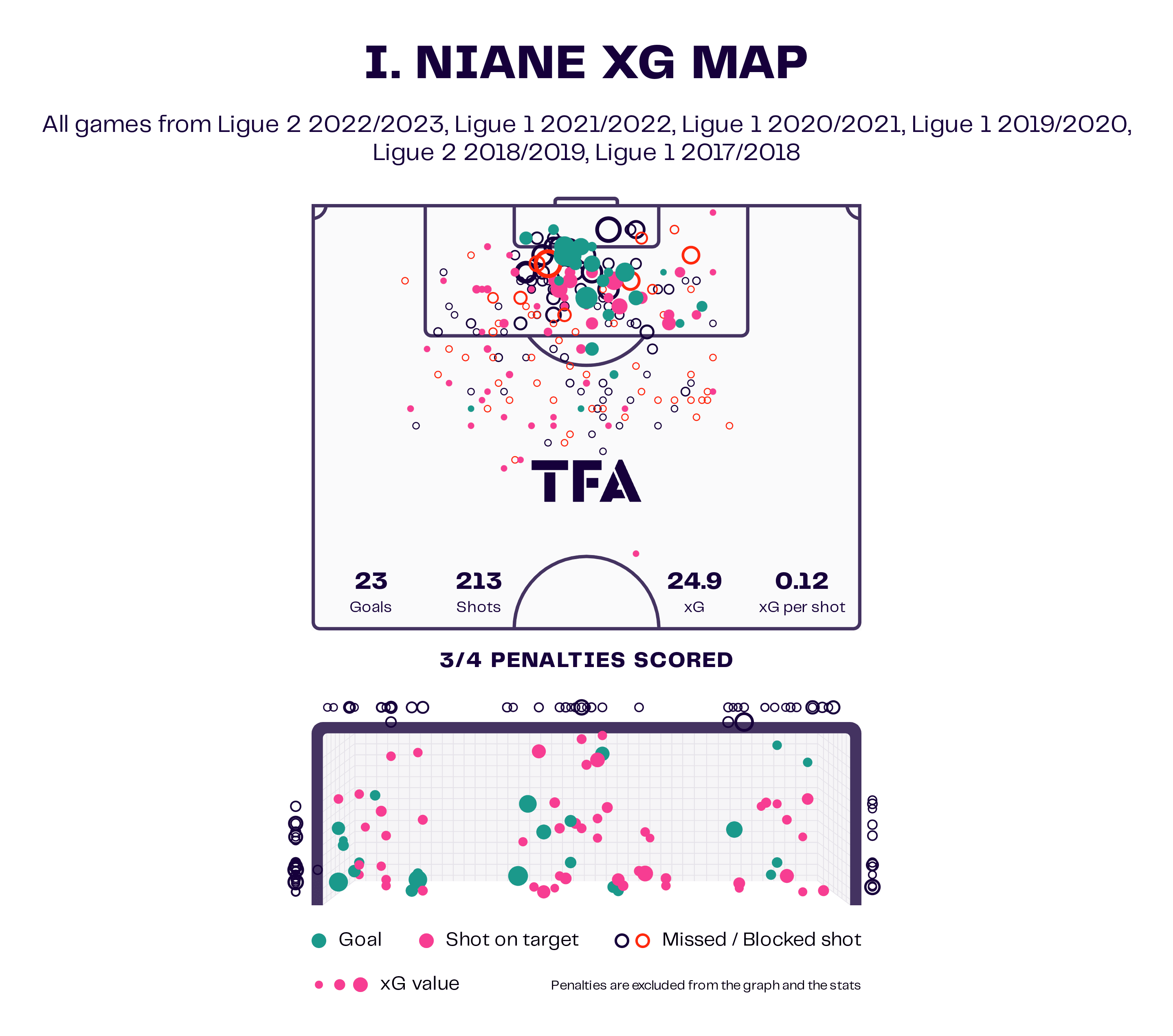
However, when looking at his entire senior league career so far, we see that his xG underperformance is not too significant in proportion to his underperformance this season and last season. While we wouldn’t say Niane is a very good finisher and there definitely is some room for improvement for the striker in this department, it’s not a massive cause for concern at the moment for Angers. Still, they’re probably not getting a player who’s going to be high on confidence in front of goal immediately, which doesn’t bode well for their relegation scrap — they need to build up Niane and hope he turns his form around quickly if they’re going to survive in Ligue 1 for next season.
As a finisher, perhaps the 187cm/6’1” Senegalese striker’s biggest issue is his one-footedness. Niane can be very reliant on his right foot at times to the hindrance of his goalscoring opportunities which can come in good positions, as we’ve seen especially from the xG map of this season in figure 14. Sometimes, the 23-year-old will force the shot with his right foot, though, rather than taking it on his left even if his left foot provides a more natural shooting option on that occasion. If shown onto his left foot, the new Angers man will likely struggle.
Niane provides a decent level of quality in the air and can be an asset contesting goal-kicks or long balls from the back, as well as a target from set pieces. Furthermore, the attacker possesses solid dribbling ability. At times, Niane likes to pull away to the left wing, receive in space out wide and then carry the ball inside; he’s capable of driving past defenders 1v1 and progressing into a decent shooting position.
Niane likes to make runs in behind the opposition’s backline but if he doesn’t receive on his initial run, he may drop off and look to provide a short option. He switches up his movement a lot, keeping defenders guessing and making himself difficult to keep track of. When he receives on dropping off with his back to goal, however, he tends to rush the play a bit. He’s undoubtedly better when receiving while facing the opposition’s goal.
This signing is one that could be wise in the long run but may be made more with an eye on potentially dropping to Ligue 2 for 2023/24 rather than in the hope of pulling off a great escape this term, from Angers’ perspective. Niane can be a good weapon in Ligue 2 and has maintained a solid xG per 90 / xG per shot rate in the second tier this term, but we’d say he’s unlikely to turn things around much for his new team in Ligue 1 at present, given their struggles and his own struggles of late.
Youssouf Ndayishimiye to Nice
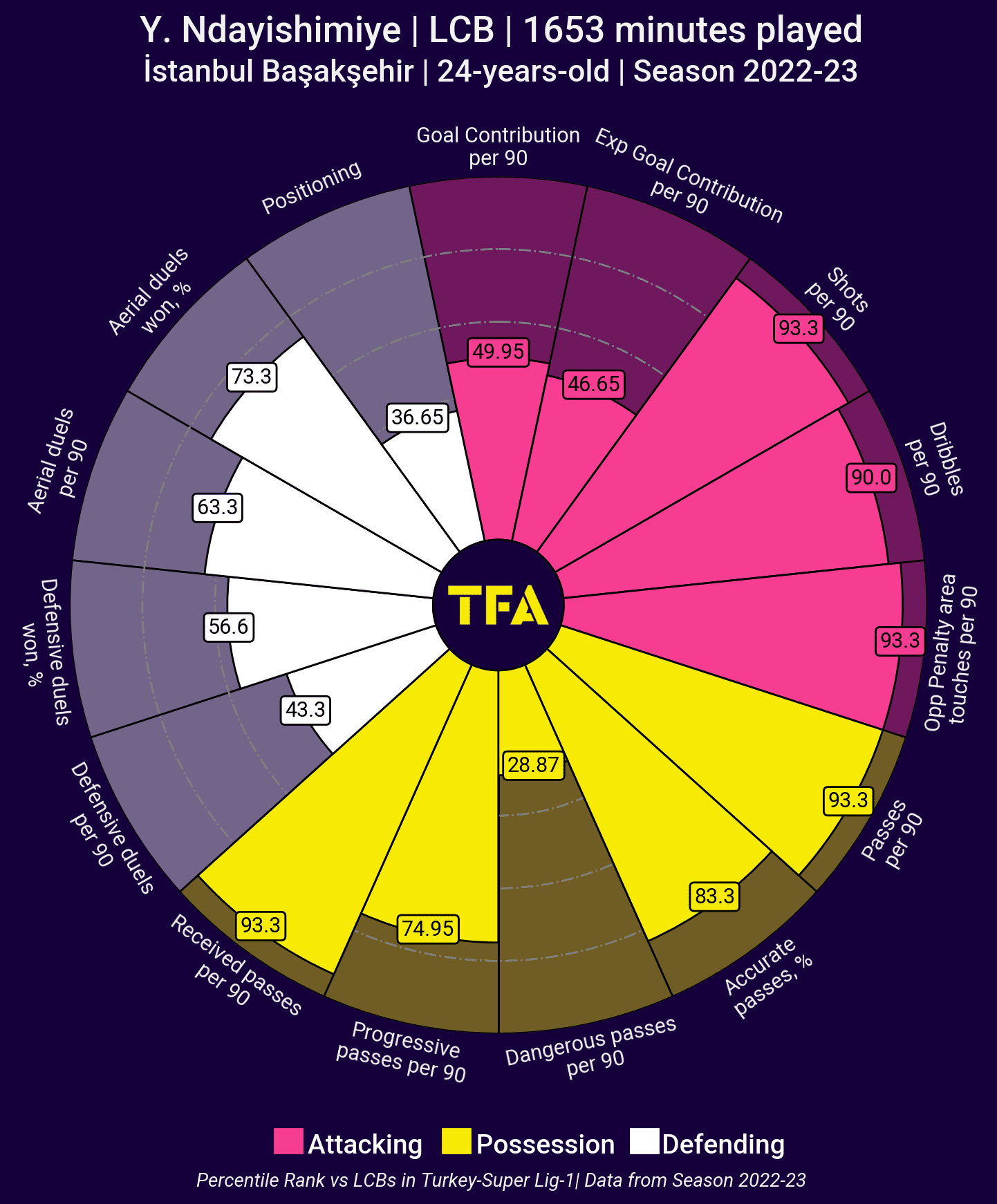
This scout report is a Nice sandwich, as we end with a transfer made by the same club we started out discussing: Nice. This time, we’re looking at Les Aiglons’ new centre-back/holding midfielder, Youssouf Ndayishimiye, who was brought in for €11.5m from Turkish Super Lig’s third-placed side, İstanbul Başakşehir F.K.
Ndayishimiye has shone in Türkiye since initially moving to Yeni Malatyaspor from Aigle Noir of his native Burundi in January 2020. Malatyaspor quickly generated a nice profit on Ndayishimiye, selling the €45k signing for €2.15m just over a year later to İstanbul Başakşehir. Now, Başakşehir have also made a hefty profit on the Burundi international, selling him for almost €10m more than they paid for him just under two years after his signing.
The 187cm/6’1” 24-year-old is capable and comfortable playing as either a holding midfielder or as a centre-back. He’s right-footed but spent plenty of time playing as a left centre-back with Başakşehir, though he made his Nice debut at right centre-back for Les Aiglons.
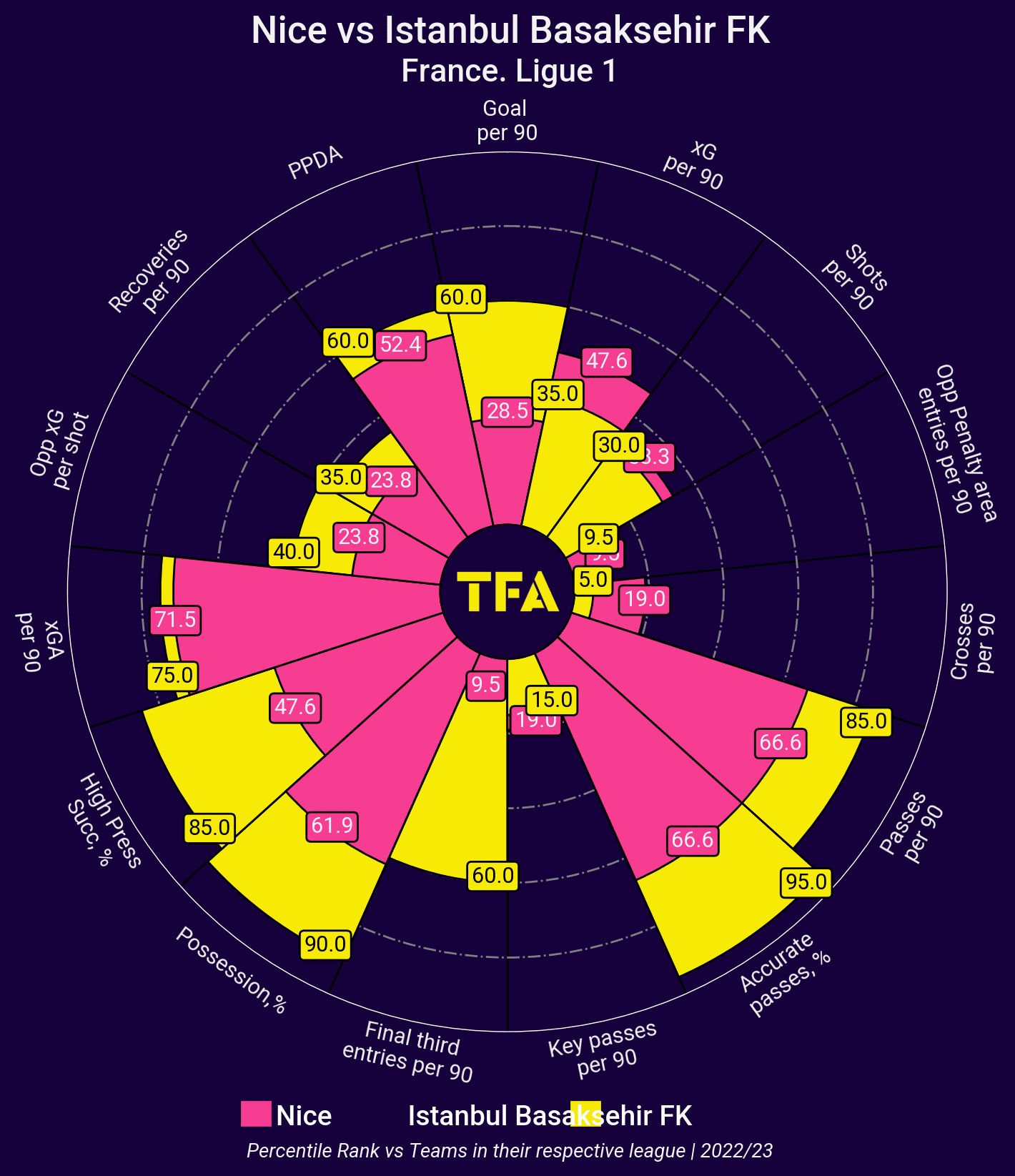
There are plenty of similarities, relative to their respective leagues, between Nice and Başakşehir. The Turkish side are one of the most possession-based sides in their country so stand out a little bit more than Nice in the possession areas but especially defensively, the two sides share plenty of similarities, except for Başakşehir’s exceptional high press success % dwarfing that of Nice.
For this possession-based side, Ndayishimiye was one of the most heavily-utilised players. The Burundi native made 63.92 passes per 90 for Başakşehir in the league this season — the second-most of any Turkish Super Lig centre-back. Meanwhile, he maintained a solid 91.74% pass success rate.
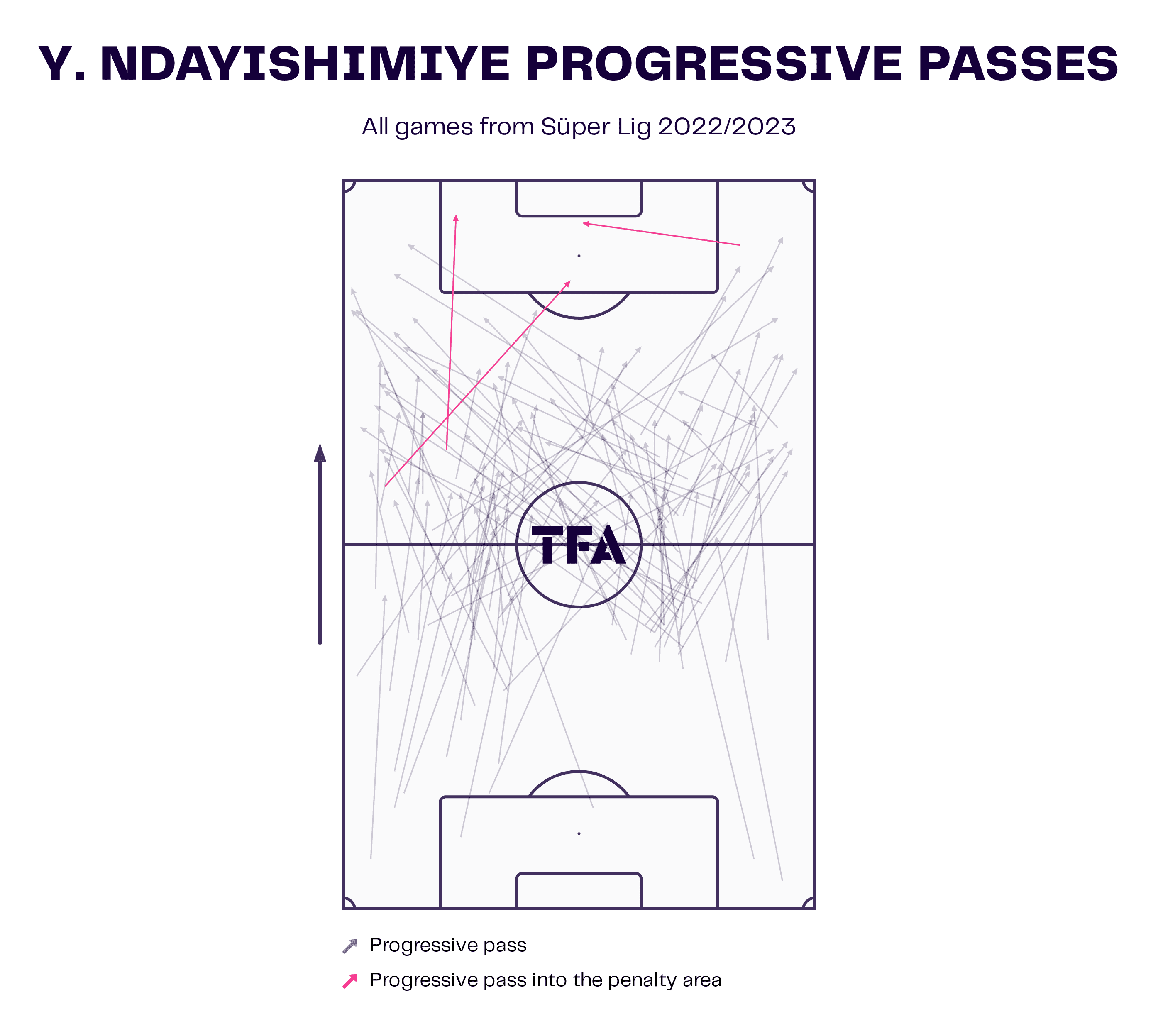
Ndayishimiye also made lots of progressive passes (8.38 per 90) in Türkiye this season, while maintaining a decent success rate (76.62%). His progressive pass map in figure 19 the kinds of progressive passes it’s been common to see the new Nice man make in Türkiye this term. We can also, again, reiterate that he’s got experience playing as a centre-back (on either side) and as a holding midfielder, explaining the variety of passing locations above.
As a midfielder, Ndayishimiye demonstrates good scanning and a decent ability to position himself in space behind the opposition’s first line of pressure. He’s capable of dropping off into space to make himself available for a pass before then receiving, turning and driving forward bravely with the ball.
We see Ndayishimiye step out with the ball and carry it forward even when playing as a centre-back. He’s a composed and confident ball carrier who’s got a good ability to protect the ball with his body while storming forward anyway. Even if challengers approach him, he’s good at keeping them away from the cherished possession while driving his team upfield and entering a better passing position.
One area in possession Ndayishimiye could improve is in terms of his long passing. He’s not a comfortable long passer and while his success rate is decent in this area, he’s often asking a lot from the receiver and not exactly setting them up for maximum success. This is why he often avoids long balls.
Defensively, Ndayishimiye is physically strong and possesses excellent timing in his tackles. He’s generally a more passive defender who takes his time before engaging a dribbler. However, he’ll be quicker to jump out when dealing with a player receiving with his back to goal. When he does commit to jumping out of the backline, the 24-year-old commits fully, meaning he can be drawn well out of position which can allow his team to get exploited.
Ndayishimiye can get his feet a bit mixed up at times and step awkwardly, making life difficult for himself when it comes to reacting quickly to a dribbler’s movement, while we do sometimes also see him commit to a sliding tackle in moments of desperation, which can be dangerous for his team.
Defensively and offensively, there are some clear issues to iron out and some clear benefits for Nice in their new signing. This is a player I’ve personally watched for quite a while thanks to his impressive positives throughout his time in Turkey, and I reckon we’ll look back on this as a good bit of business from Nice, though time will tell how Ndayishimiye adapts to the league and to the level in France, which is always tough to predict and can depend on many variable factors.
Conclusion
To conclude our scout report, we hope these five late-January transfer window deals have been adequately analysed to show why we decided to highlight them, specifically, in this piece. Track these players with us and see how their respective moves turn out in the long run; we feel they are definitely five interesting ones worth tracking, however, for the reasons explained, though that does not mean we feel they are guaranteed successes.

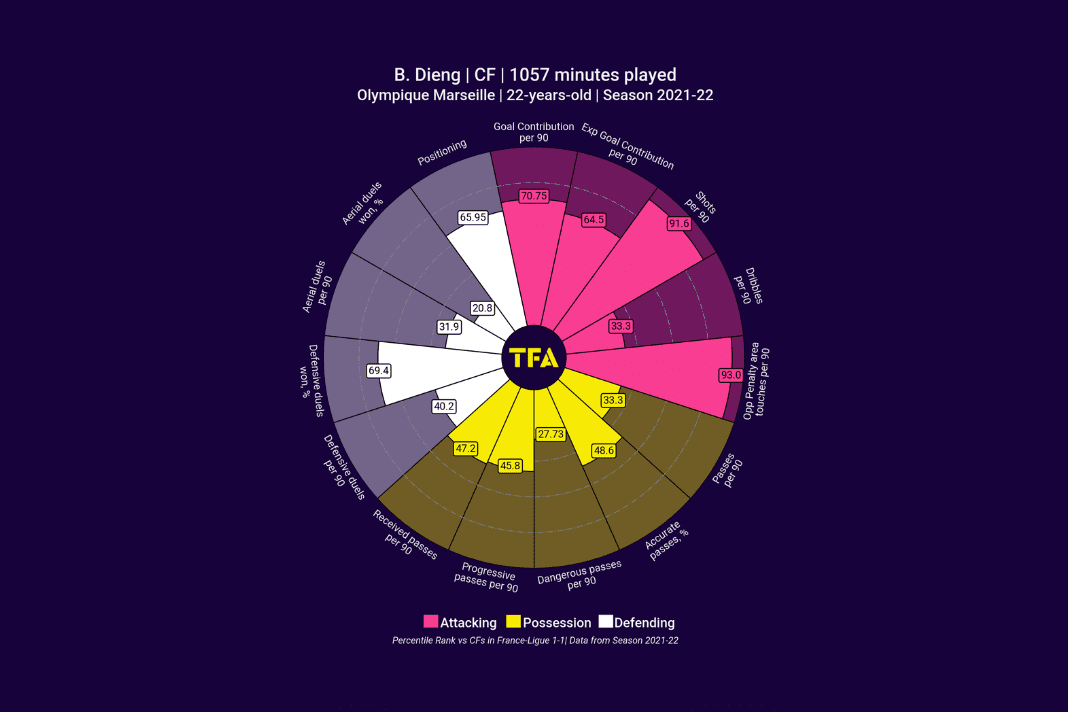



Comments